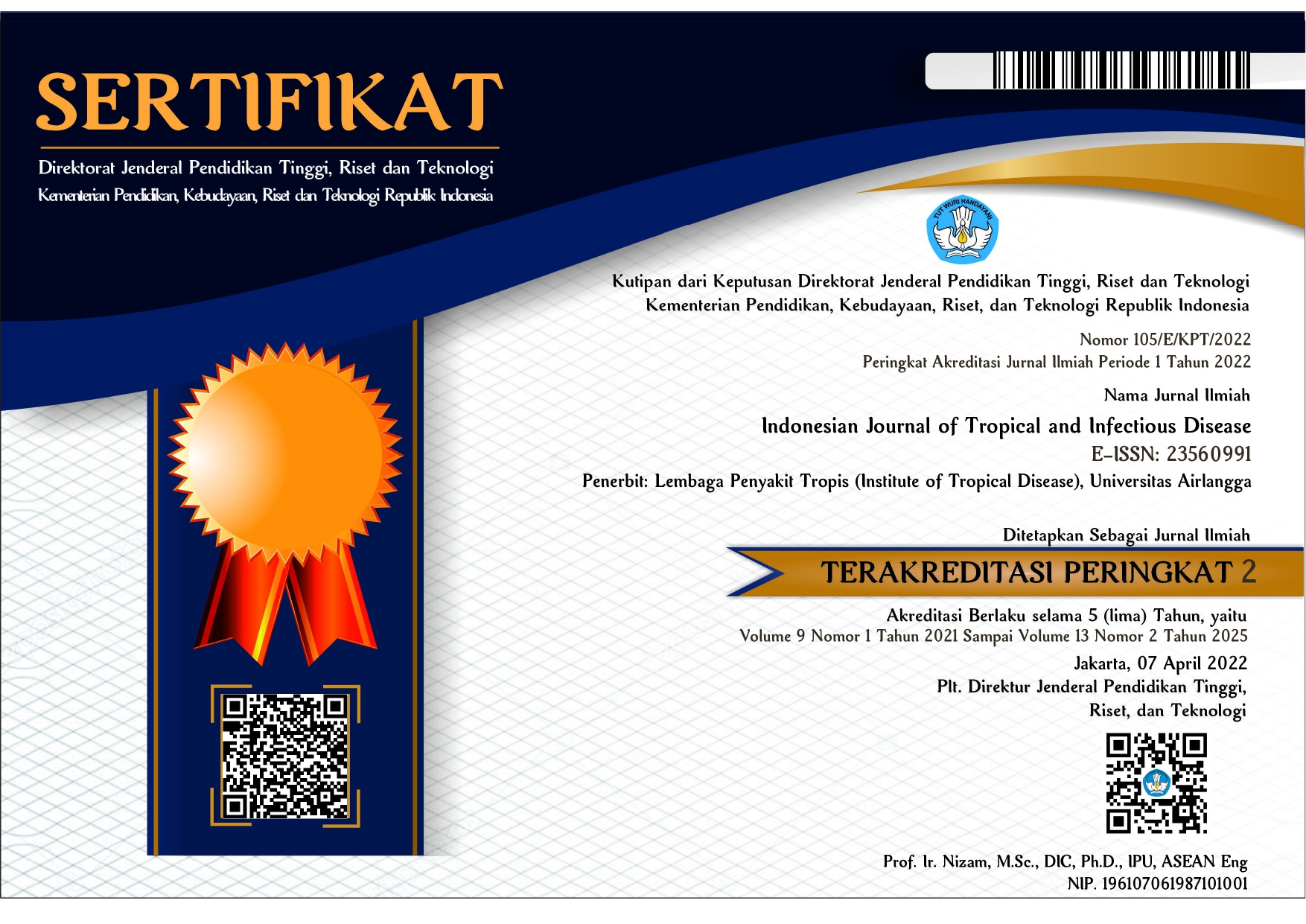ONYCHOMYCOSIS FINGER AND TOE NAIL BY CRYPTOCOCCUS LAURENTII.T VERRUCOSSUM AND CANDIDA SP
Downloads
Onychomycosis is the most common nail disease and contributes to 50% of all cause of onychodystropy. Onychomycosis cases due to Cryptoccus laurentii and Trychophyton spp. are quite rare. The most common cause of onychomycosis reported in Indonesia is Candida sp. Risk factors for onychomycosis include moisture, occlusion, nail trauma, decreased immunity, slow nail growth, wide nail surface, and genetic factors. Old age, cancer, psoriasis, dermatophyte infection at other sites is also a risk factor. A 54 year-old woman, with brittle nails and cracked palms since 6 months before came to outpatient clinic. She is a farmer and work in the rice fields without gloves daily; she also rarely wash her hands after work. Dermatologic examination of all right and left finger nail is revealed yellow, white, and some blackish discoloration, subungual hyperkeratotic, onycholysis, and onychodystrophy. In the right and left palm, revealed multiple erythematous and yellow-white hyperkeratotic plaques, with fissures and rough scales. From nail clippings, a 20% KOH examination revealed long branching hyphae, periodic Acid-Schiff (PAS) staining revealed spores, and fungal culture revealed growth of Criptococcus laurentii and Trichophyton spp. colonies. We gave itraconazole pulse dose: 2 x 200 mg tablet orally per day for a week every month. Other treatment was using 20% urea cream. Follow up at 8 weeks after therapy is showed clinical and mycologic improvement. The incidence of onychomycosis due to Cryptoccus laurentii and Trychophyton spp. is still rare. Thepredisposing factor of infection in these case is suspected due to old age and her habitual contact with the paddy fields without gloves and rarely wash her hand after work.
K B, W I, LM R, S W, E E. Dermatomikosis Superfisialis edisi ke-2. 2nd ed. Jakarta: Badan Penerbit FKUI; 2013. 86-97 p.
K W, LA G, SI K, BA G, AS P, DJ L. Fitzpatrick's Dermatology in General Medicine edisi ke-8 vol.2. 8th ed. New York: McGraw-Hill Co; 2012. 2277-320 p.
Yenişehirli G, Bulut Y, Sezer E, Günday E. Onychomycosis infections in the Middle Black Sea Region, Turkey. Int J Dermatol. 2009 Sep;48(9):956–9.
Banerjee P, Haider M, Trehan V, Mishra B, Thakur A, Dogra V, et al. Cryptococcus laurentii fungemia. Indian J Med Microbiol. 31(1):75–7.
Carrillo-Muñoz AJ, Quindós G, Del Valle O, Santos P, Giusiano G, Guardia C, et al. In vitro antifungal activity of sertaconazole nitrate against recent isolates of onychomycosis causative agents. J Chemother. 2008 Aug;20(4):521–3.
Ritterband DC, Seedor JA, Shah MK, Waheed S, Schorr I. A unique case of Cryptococcus laurentii keratitis spread by a rigid gas permeable contact lens in a patient with onychomycosis. Cornea. 1998 Jan;17(1):115–8.
Manzano-Gayosso P, Hernández-Hernández F, Méndez-Tovar LJ, Palacios-Morales Y, Córdova-Martínez E, Bazán-Mora E, et al. Onychomycosis incidence in type 2 diabetes mellitus patients. Mycopathologia. 2008 Jul;166(1):41–5.
El-Tras WF, Tayel AA, Mohamed RA, El-Kordy DM, El-Kady NN, Samir A. Mixed rearing correlates with the existence of Trichophyton verrucosum pathogens in humans. Dermatologica Sin. 2015 Sep;33(3):130–3.
Tay ST, Na SL, Tajuddin TH. Natural occurrence and growth reaction on canavanine-glycine-bromothymol blue agar of non-neoformans Cryptococcus spp. in Malaysia. Mycoses. 2008;51(6):515–9.
Rosario I, Soro G, Deniz S, Ferrer O, Acosta F, Padilla D, et al. Presence of C. albidus, C. laurentii and C. uniguttulatus in crop and droppings of pigeon lofts (Columba livia). Mycopathologia. 2009;169(4):315–9.
Ferreira-Paim K, Andrade-Silva L, Mora DJ, Pedrosa AL, Rodrigues V, Silva-Vergara ML. Genotyping of Cryptococcus neoformans isolated from captive birds in Uberaba, Minas Gerais, Brazil. Mycoses. 2011;54(5):e294–e300.
Krcmery V Jr, Kunova A, Mardiak J. Nosocomial Cryptococcus laurentii fungemia in a bone marrow transplant patient after prophylaxis with ketoconazole successfully treated with oral fluconazole. Infection. 1997;25(2):130.
Bauters TG, Swinne D, Boekhout T, Noens L, Nelis HJ. Repeated isolation of Cryptococcus laurentii from the oropharynx of an immunocompromized patient. Mycopathologia. 2002;153(3):133–5.
Furman-Kuklinska K, Naumnik B, Mysliwiec M. Fungaemia due to Cryptococcus laurentii as a complication of immunosuppressive therapy: a case report. Adv Med Sci. 2009;54(1):116–9
Elewski BE, Charif MA. Prevalence of onychomycosis in patients attending a dermatology clinic in Northeastern Ohio for other conditions. Arch Dermatol. 1997;133:1172–1173.
Scher RK, Rich P, Pariser D, Elewski B. The epidemiology, etiology, and pathophysiology of onychomycosis. Semin Cutan Med Surg. 2013 Jun;32(2 Suppl 1):S2-4.
Ahmed A, Ali E, Khondker L, Khan MS. Pulse dose of oral itraconazole is effective in the treatment of onychomycosis. Journal of Pakistan Association of Dermatology. 2016 Dec 22;21(4):276-80.
Arenas RJ. Dominguez-Cherit, Fernandez LM. Open randomized comparison of itraconazole versus terbinafine in onychomycosis. Int J Dermatol 1995; 34:138-43.
Ferreira-Paim K, Andrade-Silva L, Mora DJ, Lages-Silva E, Pedrosa AL, Da Silva PR, Andrade AA, Silva-Vergara ML. Antifungal susceptibility, enzymatic activity, PCR-fingerprinting and ITS sequencing of environmental Cryptococcus laurentii isolates from Uberaba, Minas Gerais, Brazil. Mycopathologia. 2012 Jul 1;174(1):41-52.
Elewski BE, Tosti A. Risk factors and comorbidities for onychomycosis: implications for treatment with topical therapy. The Journal of clinical and aesthetic dermatology. 2015 Nov;8(11):38.
Abdullah L, Abbas O. Common nail changes and disorders in older people: Diagnosis and management. Can Fam Physician. 2011 Feb;57(2):173–81.
Copyright (c) 2018 Indonesian Journal of Tropical and Infectious Disease

This work is licensed under a Creative Commons Attribution-NonCommercial-ShareAlike 4.0 International License.
The Indonesian Journal of Tropical and Infectious Disease (IJTID) is a scientific peer-reviewed journal freely available to be accessed, downloaded, and used for research. All articles published in the IJTID are licensed under the Creative Commons Attribution-NonCommercial-ShareAlike 4.0 International License, which is under the following terms:
Attribution ” You must give appropriate credit, link to the license, and indicate if changes were made. You may do so reasonably, but not in any way that suggests the licensor endorses you or your use.
NonCommercial ” You may not use the material for commercial purposes.
ShareAlike ” If you remix, transform, or build upon the material, you must distribute your contributions under the same license as the original.
No additional restrictions ” You may not apply legal terms or technological measures that legally restrict others from doing anything the license permits.























